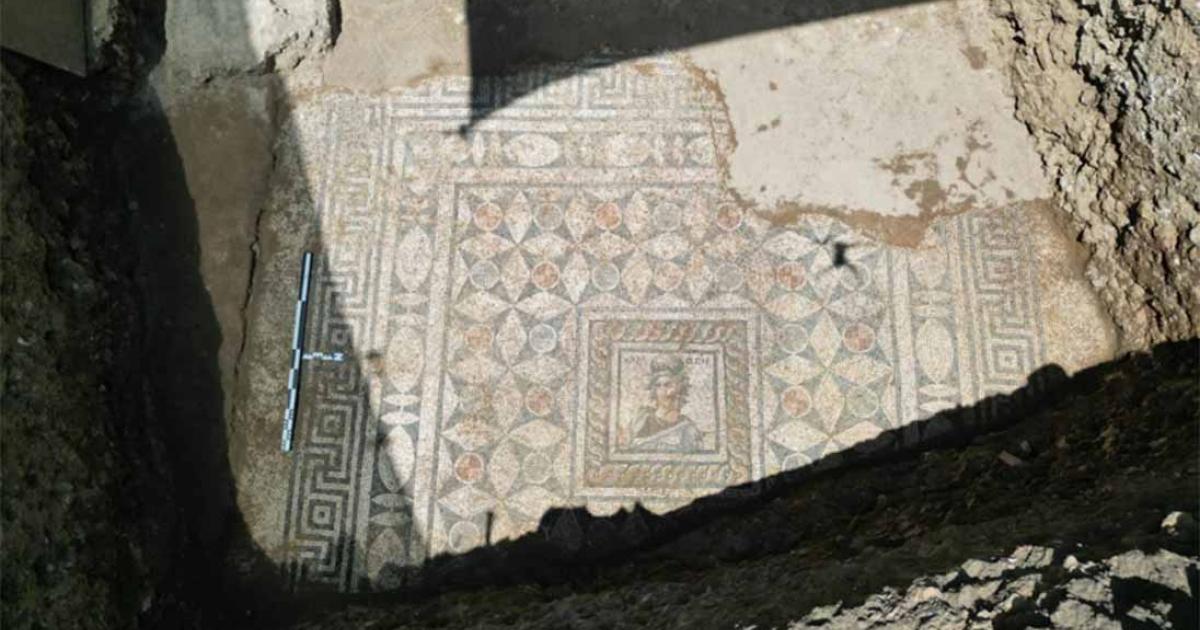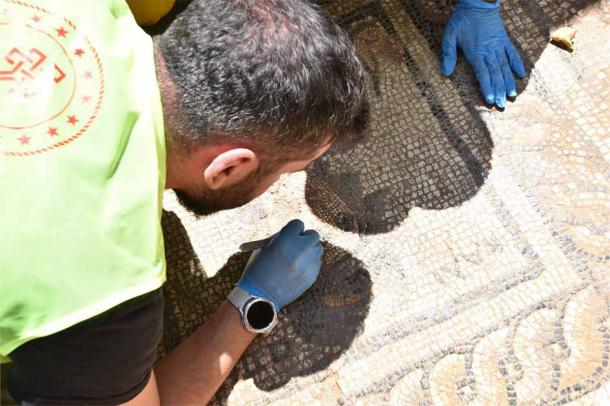Introduction
In the heart of Turkey’s stunning southern coastline, the ancient city of Side has long been a treasure trove for archaeologists and historians. Recently, an extraordinary discovery has shed new light on the city’s rich Hellenistic past – the unearthing of a beautifully preserved mosaic floor dating back to the 2nd century BC. What makes this find so remarkable is the portrait it depicts – that of Calliope, one of the legendary Nine Muses from Greek and Roman mythology.
This remarkable mosaic, discovered as part of an ongoing restoration project in Side, offers a tantalizing glimpse into the cultural and spiritual life of this ancient Greek settlement. As we delve into the story behind this captivating artwork, we’ll explore the significance of the Muses in Greek mythology, the vibrant history of the city of Side, and the importance of this latest archaeological treasure trove.

The City of Side: A Greek Settlement Dedicated to the Gods
Located in the Antalya province of southern Turkey, the ancient city of Side has a rich and complex history dating back to the 7th century BC. Founded by Greek colonists from Western Anatolia, Side flourished for centuries as both a bustling commercial port and a center of Hellenistic culture.
Over the centuries, Side was conquered by a succession of powers, including the Lydians, Persians, and Alexander the Great. But it was during the Hellenistic period, between the 4th and 1st centuries BC, that the city truly came into its own as a hub of Greek cultural and religious life. This was the era when the worship of the Nine Muses, including the revered Calliope, took hold in Side.
The city’s strategic location on the Mediterranean made it an important trading hub, and under Roman rule in the 1st century BC, Side continued to thrive as a commercial center. However, the city’s Greek heritage and the influence of the Muses never faded, even as Roman culture and architecture became increasingly prominent.
The Muses: Daughters of Zeus and Goddesses of the Arts
In Greek mythology, the Muses were the nine daughters of Zeus, the king of the gods, and Mnemosyne, the goddess of memory. These divine figures were believed to be the source of inspiration for the arts, including poetry, music, dance, and the visual arts.
Each Muse was associated with a specific creative discipline. Calliope, the subject of the newly discovered mosaic, was revered as the Muse of epic poetry and eloquent speech. She was often depicted holding a writing tablet and stylus, symbolizing her role as the patron of creative writing and storytelling.

The Muses were first introduced to a wider Greek audience through the epic poem “Theogony” by the ancient poet Hesiod, written between 730 and 700 BC. This work detailed the origins and genealogies of the Greek gods, including the Nine Muses and their divine lineage.
Over time, the Muses became deeply embedded in Greek and later Roman culture, inspiring artists, poets, and leaders alike. Even today, the idea of finding one’s “muse” to ignite creative inspiration remains a powerful concept in the Western artistic tradition.

The Discovery of the Calliope Mosaic
The recent excavations in Side that uncovered the stunning mosaic depicting Calliope are part of an ongoing restoration project led by Turkey’s Ministry of Culture and Tourism. The mosaic, which dates back to the 2nd century BC, was discovered as part of the meticulous work to uncover and preserve the ancient city’s Hellenistic-era ruins.
The mosaic itself is a true masterpiece of ancient craftsmanship. Composed of tiny, precisely placed tesserae (mosaic tiles), the portrait of Calliope is remarkably well-preserved, showcasing the Muse’s serene and dignified expression. The attention to detail is truly breathtaking, from the delicate folds of her garment to the subtle shading that brings her features to life.
This discovery is particularly significant because it provides a tangible link to the Hellenistic culture that once thrived in Side. While the city is renowned for its Roman-era ruins, the Calliope mosaic offers a rare glimpse into the earlier Greek heritage of the settlement. It highlights the enduring influence of the Muses and the central role they played in the spiritual and cultural life of ancient Greek communities.

The Ongoing Excavations in Side
The excavations that unearthed the Calliope mosaic are part of a larger, long-term project to uncover and restore the ancient city of Side. Sponsored by Turkey’s Ministry of Culture and Tourism, these archaeological efforts have been ongoing for decades, steadily revealing the layers of history that lie beneath the modern-day resort town.
Much of what is currently visible in Side consists of monuments, public buildings, and infrastructure dating back to the Roman era, when the city was a thriving commercial center. However, the discovery of the Calliope mosaic and other Hellenistic-era artifacts demonstrates that there is still a wealth of ancient Greek history waiting to be uncovered.
As the excavations continue, archaeologists are hopeful that they will uncover even more insights into the city’s Greek origins and the enduring influence of the Muses. The Calliope mosaic is just the latest in a series of remarkable finds that are shedding new light on the rich cultural heritage of this ancient Mediterranean settlement.
Conclusion: Honoring the Muse of Epic Poetry
The discovery of the stunning mosaic depicting the Muse Calliope in the ancient city of Side is a testament to the enduring power of Greek mythology and the lasting impact of the Muses on Western civilization. This captivating artwork, dating back over 2,000 years, offers a window into the vibrant Hellenistic culture that once thrived in this coastal Turkish city.
As the ongoing excavations in Side continue to yield new insights into the city’s past, the Calliope mosaic stands as a reminder of the rich artistic and spiritual traditions that shaped the ancient Greek world. It is a testament to the timeless inspiration that the Muses have provided to poets, artists, and thinkers throughout history.
In honoring Calliope, the Muse of epic poetry and creative expression, this remarkable mosaic invites us to reflect on the enduring power of storytelling, the written word, and the human desire to capture the beauty and wonder of the world around us. It is a treasure trove of ancient wisdom and a testament to the resilience of the human spirit.

